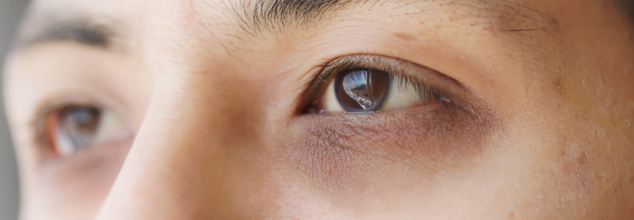- Health Conditions A-Z
- Health & Wellness
- Nutrition
- Fitness
- Health News
- Ayurveda
- Videos
- Medicine A-Z
- Parenting
- Web Stories
Do Dark Circles Mean More Than Just Stress And Sleep Deprivation?

(Credit-Canva)
When people see dark circles, they immediately assume you lack sleep. One of the first thoughts that cross people’s minds is that ‘this person needs to take a nap really bad’. But is that all there is to it? Dark circles are hyperpigmentation that develop around one’s eyes. Many try to cover it with make-up or opt for cosmetic procedures, but what if you get to know this feature is a sign of something worse?
Some people believe that dark circles are solely cosmetic issues, but studies show that hyperpigmentation could allude to something bigger. If your dark circles aren't from a health problem, there are other reasons why you might have them. One big reason is your family. If your parents or brothers and sisters have dark circles, you're more likely to have them too. Also, the shape of your face can make a difference. If your eyes are deep-set, the shadows can make the skin look darker. One thing you must remember is that dark circles are a symptom, not an illness or disease itself. While you can apply creams and serums to lower its effects, unless you resolve or understand the reason why you have dark circles, you may not be able to handle them as efficiently.
What Are Some Conditions That Cause Dark Circles?
Dark circles under your eyes aren't always just because you're tired. Sometimes, it's allergies, like when your nose gets stuffy. Or, it could be your thyroid, which is a little gland in your neck that helps control your body. And, as you get older, your skin changes, and that can make dark circles show up more. The color of the circles can be different, like blue or brown, depending on your skin. Most of the time, they're not a sign of anything bad. But you might want to make them less noticeable because you don't like how they look. Sometimes, they can tell you that you need to sleep more or eat better.
Lots of things can cause dark circles. If you don't sleep well or enough, you'll probably get them. If you have allergies, your eyes might get puffy and dark. When your body makes too much of the stuff that colors your skin, it can make dark circles. As you get older, you lose fat around your eyes, and your skin gets thinner, which makes dark circles worse. If you don't have enough iron, or if you're in the sun too much, or if you rub your eyes a lot, that can cause dark circles too. Smoking, having problems with your thyroid, and not drinking enough water can also make them happen. Some eye drops can even make your eyes look dark. If you have dark skin, or if you're older, or if your parents had dark circles, you're more likely to get them too. While they may be a harmless feature, this darkening of skin affects a lot of people mentally and emotionally. Here are some home remedies you can try to help with it.
Home Remedies To Tackle Dark Circles
Simple Home Fixes for Dark Circles: Easy home tricks can lessen dark circles. Though not always proven, they're cheap and safe, offering a natural way to improve under-eye appearance.
Restful Sleep for Brighter Eyes: Getting enough good sleep helps reduce dark circles. Elevating your head with extra pillows can also minimize puffiness and under-eye shadows.
Cool Cucumber Relief: Cucumber slices soothe tired eyes and reduce swelling. Their water and vitamin C nourish skin, while silica supports healthy tissue, easing dark circle visibility.
Tea Bag Eye Refreshment: Tea bags can reduce dark circles and puffiness. Caffeine's antioxidants boost circulation. Cooled tea bags offer soothing relief when placed over the eyes.
Facial Massage and Cold Compresses: Gentle facial massages improve eye circulation, reducing dark circles. Cold compresses also lessen puffiness, offering simple ways to brighten the under-eye area.
Antioxidant Skin Care Benefits: Creams with antioxidants like vitamins E and C can improve dark circles. These products help treat under-eye discoloration, promoting a more refreshed look.
Heart Attack Rates Have Decreased, But Number Of Chronic Cardiac Diseases Have Risen: Study

(Credit-Canva)
Heart health or cardiovascular diseases are the leading causes of mortality in the world. In 2019, 17.9 million people died due to cardiovascular diseases with 85% of these deaths attributed to heart attacks and strokes. There are many types of cardiovascular diseases, many of which are chronic diseases. While the numbers of death due to heart attacks may seem high, new study published in the Journal of the American Heart Association shows these numbers have actually decreased. However, while these numbers went down, chronic diseases have seen a rise.
How Have Heart Disease Deaths Changed Over Time?
To understand how heart disease deaths have changed, researchers looked at national data from 1970 to 2022, focusing on adults aged 25 and older. Heart disease covers many different heart problems. Even though heart disease remains the leading cause of death in the U.S. (responsible for 24% of all deaths in 2022), the total number of deaths from heart disease actually went down by 66%.
Deaths from ischemic heart disease (the most common type, caused by blocked arteries) dropped significantly, from 91% to 53% of all heart disease deaths. Deaths from heart attacks (often the first sign of ischemic heart disease) fell by a huge 89%, making up less than a third of all heart disease deaths in 2022. But the study also found a big increase in other heart conditions, which now account for nearly half of all heart disease deaths. The three conditions that rose the most were:
Hypertensive heart disease
Deaths from this condition, caused by long-term high blood pressure, went up by 106%. It now makes up 13% of all heart-related deaths.
Heart failure
Deaths from this condition, where the heart can't pump enough blood over time, rose by 146%. It now accounts for 12% of all heart-related deaths.
Arrhythmias (irregular heartbeats)
Deaths from arrhythmias, where the heart beats too fast, too slow, or unevenly, soared by 450%. They now make up 4% of all heart-related deaths.
One of the study's authors mentioned that while these trends are "quite clear," some changes in how deaths were categorized might have caused small inaccuracies. Also, the study didn't fully consider how other health problems or things like race might have affected the results. For example, some heart problems might have been underestimated if they stemmed from ischemic heart disease.
Despite these minor points, experts agree the study provides "valuable insights" and is a "well-designed, large-scale study" using over 50 years of data.
Why the Shift to Chronic Heart Conditions?
Experts believe the drop in some heart disease deaths is due to better ways to diagnose problems and improved care. This includes new medicines and procedures that help restore blood flow to the heart.
However, many people who survive a heart attack go on to develop other heart conditions like heart failure or arrhythmias. When you combine this with a growing older population and rising rates of obesity, diabetes, and high blood pressure, it creates "the perfect storm for chronic cardiac disease." This new "wave of chronic heart disease deaths" mainly affects older adults and those with several health issues.
How to Protect Your Heart?
To keep your heart healthy, focus on a few key areas: know your numbers by tracking your blood pressure, cholesterol, blood sugar, and weight, as early detection of issues is vital. Stay active with at least 150 minutes of moderate exercise weekly; even walking can significantly improve heart function. Eat a nutritious diet rich in vegetables, fruits, whole grains, lean proteins, and healthy fats, following heart-healthy guidelines. Avoid smoking or seek help to quit, as it's a primary cause of heart disease. Finally, manage stress and get enough sleep, as these often-overlooked factors are crucial for reducing your heart risk.
Drinking Sugary Drinks Is Worse Than Eating Sugar - How You Consume It Matters More Than How Much

(Credit-Canva)
For many health-conscious people, sugar is the biggest health mistake they can make. Having earned a bad reputation, many people avoid sugary foods and opt for sweet fruit drinks instead. However, these juices and sugary drinks may be worse for your health than sweet desserts are. New research suggests that how you get your sugar might be just as important as how much you have.
Liquid vs. Solid Sugar
A new study published in the journal Advances in Nutrition, indicates that drinking sugary beverages like soda may increase your risk of type 2 diabetes more than eating sugary foods such as cookies and cakes.
Experts say this research is important because it shows the way sugar is consumed really matters. Instead of just saying "cut all sugar," we now have strong proof that where the sugar comes from, its form, and what it's eaten with are key to your health risk.
Surprising Findings About Sugar
The study found that at how different types of sugar affect health, researchers reviewed the habits of over 500,000 people. Their main finding was surprising: sugar from solid foods wasn't linked to a higher risk of type 2 diabetes, but sugar from drinks was.
Specifically, for every extra 12-ounce sugary drink you had daily, your risk of developing type 2 diabetes went up by 25%. Even fruit juice had an effect, with an extra 8-ounce serving raising the risk by 5%.
Interestingly, sugar from food not only didn't connect to diabetes risk, but in some cases, it seemed to offer some protection. Having a small amount of table sugar or total sugar (including natural sugar) daily was actually linked to a lower risk of type 2 diabetes.
These findings together show that "not all sugars are the same."
It's important to remember that this study only shows a connection between sugary drinks and type 2 diabetes, not that they directly cause it. While most studies considered things like body weight and smoking, other lifestyle habits could still play a role. For example, people who drink a lot of these beverages might also be less active, which can affect diabetes risk. Still, experts say the study is very thorough.
Why Liquid Sugar Might Be Worse
Sugary drinks might be more harmful because they don't have the fiber, protein, or fat that typically slow down digestion in solid foods.
This means liquid sugar gets into your bloodstream very quickly. This causes a sudden jump in blood sugar and insulin levels, and your brain doesn't get the signal that you're full. This fast intake can also make it hard for your liver to process the sugar, especially the fructose part.
In large amounts, fructose turns into fat in your liver. This buildup of fat is linked to metabolic problems that lead to type 2 diabetes. Other things in sugary drinks, like chemical additives and artificial colors, can also mess with your body's balance. Basically, sugary drinks like sports drinks, sodas, and cocktails are generally "bad for your health and should be had with care—or ideally, not at all."
How to Cut Back on Sugary Drinks
Sugary drinks can feel addictive. If you find yourself hooked, try to slowly reduce how much you drink, just like you would with alcohol or tobacco. It helps to plan ahead for when you usually crave a soda.
You can start by mixing plain sparkling water with an equal amount of fruit juice or soda. Then, week by week, slowly reduce the amount of the sugary drink until you're mostly just drinking sparkling water. If it helps, add a little lemon or lime juice for flavor. Make this your new habit.
What Really Clogs Your Arteries? Tips To Keep Your Heart Healthy

Credits: Canva
You've heard of "clogged arteries," but do you truly understand what is going on in your body? It's not merely a matter of consuming too many cheeseburgers. Something known as atherosclerosis—a gradual, insidious accumulation of plaque composed of cholesterol, fats, calcium, and other materials—lies beneath the surface, often the true cause of heart attacks and strokes.
Cardiovascular disease is still among the biggest killers globally, and a lot of the risk comes from its invisibility. Atherosclerosis, which is sometimes referred to as the silent killer, slowly plugs up arteries and lays the groundwork for heart attacks and strokes well before they manifest. The best news? With the proper information and preventive actions, you can shield your arteries and heart.
This is the thing: this toxic buildup doesn't present symptoms until it has already done substantial harm. Cardiovascular disease, says the American Heart Association, is the number one cause of death worldwide, and atherosclerosis is at the center of the epidemic.
But the good news is: atherosclerosis can be prevented, even reversed in some instances—if you know how it comes about, how to detect its signs early on, and what changes in lifestyle can actually safeguard your heart.
What is Atherosclerosis?
Atherosclerosis is a disease where plaque accumulates on the arteries' walls. This plaque is composed of cholesterol, fat, calcium, and other substances moving through the blood. Eventually, these deposits harden and constrict the arteries, decreasing blood supply to organs.
"Atherosclerosis is a devious, even lethal illness wherein artery walls get clogged with plaque," describes Dr. Paneendra S, Orthopedic Surgeon. "Atherosclerosis develops over the course of many years and usually is without symptoms until it leads to a life-threatening event such as a heart attack or stroke."
The illness usually starts when the lining of the arteries inside, the endothelium, is damaged. A number of reasons are responsible for this damage, such as:
- Smoking
- High cholesterol
- Diabetes
- High blood pressure
- Chronic inflammation
"Once the endothelium has been hurt, LDL (low-density lipoprotein) cholesterol can filter through the arterial wall," says Dr. Paneendra. "White blood cells rush in to break down the cholesterol, but this reaction creates fatty nodules called atheromas."
These atheromas may develop and then rupture, producing clots that either occlude the artery in which they were formed or embolize to a different location within the body, obstructing an organ elsewhere.
Warning Signs and Where They Appear
Although dangerous, atherosclerosis typically develops silently. Its warning signs first become apparent only when blockage is complete. Depending on the arteries involved, the signs are variable:
Heart (Coronary Arteries): Chest pain or discomfort, also referred to as angina.
Legs (Peripheral Arteries): Pain that occurs during walking (claudication), numbness, or non-healing sores.
Brain (Carotid Arteries): Slurred speech, numbness, or weakness—often stroke warning signs.
Feet and Toes: Burning, color changes, or chronic ulcers caused by inadequate circulation.
These symptoms indicate that one of the primary arteries has already experienced extensive narrowing or blockage. Early treatment and control are important to avert permanent damage.
Role of Inflammation and Lifestyle For Heart Damage
Chronic inflammation is a key contributor to the formation of atherosclerosis. Obesity, lack of exercise, and dietary factors cause chronic inflammation, which further accelerates arterial damage.
The diet rich in saturated and trans fats raises the level of LDL cholesterol, while fruits, vegetables, and fiber intake ensures your body has natural ant-inflammatory power.
How You Can Prevent This Life-Threatening Heart Condition?
Because atherosclerosis progresses silently, prevention is more important. Here's how you can regain control of your heart health:
1. Eat a Heart-Healthy Diet
Emphasize whole grains, leafy greens, berries, nuts, and healthy fats such as olive oil. Reduce your intake of processed foods, red meat, and sweetened drinks.
2. Exercise Regularly
Strive for at least 150 minutes of moderate aerobic exercise a week, including brisk walking, cycling, or swimming.
3. Quit Smoking
Smoking is one of the most significant risk factors. Quitting dramatically reduces the risk of arterial plaque buildup.
4. Manage Stress
Chronic stress can raise blood pressure and trigger inflammation. Practice mindfulness, yoga, or deep breathing techniques.
5. Monitor Blood Pressure and Cholesterol
Routine health checkups can help detect high cholesterol or hypertension early, allowing for timely intervention.
6. Control Blood Sugar
For individuals with diabetes or prediabetes, blood sugar control is essential to minimize inflammation and artery damage.
When to Seek Medical Help?
Even if you don't have symptoms, if you have several risk factors—like a history of heart disease in your family, smoking, or high cholesterol levels—it's crucial to see a healthcare professional. Tests for screening purposes such as cholesterol panels, blood pressure checks, and even coronary calcium scans can evaluate your risk.
"Overall, atherosclerosis is frequently unsuspect, progressive disease that can be severely damaging to cardiovascular health," cautions Dr. Paneendra. "Because symptoms only typically appear after widespread damage, early detection and prevention are critical."
Dr. Paneendra S is an Orthopedic Surgeon at Apollo Spectra Hospital, Bangalore in India
© 2024 Bennett, Coleman & Company Limited

